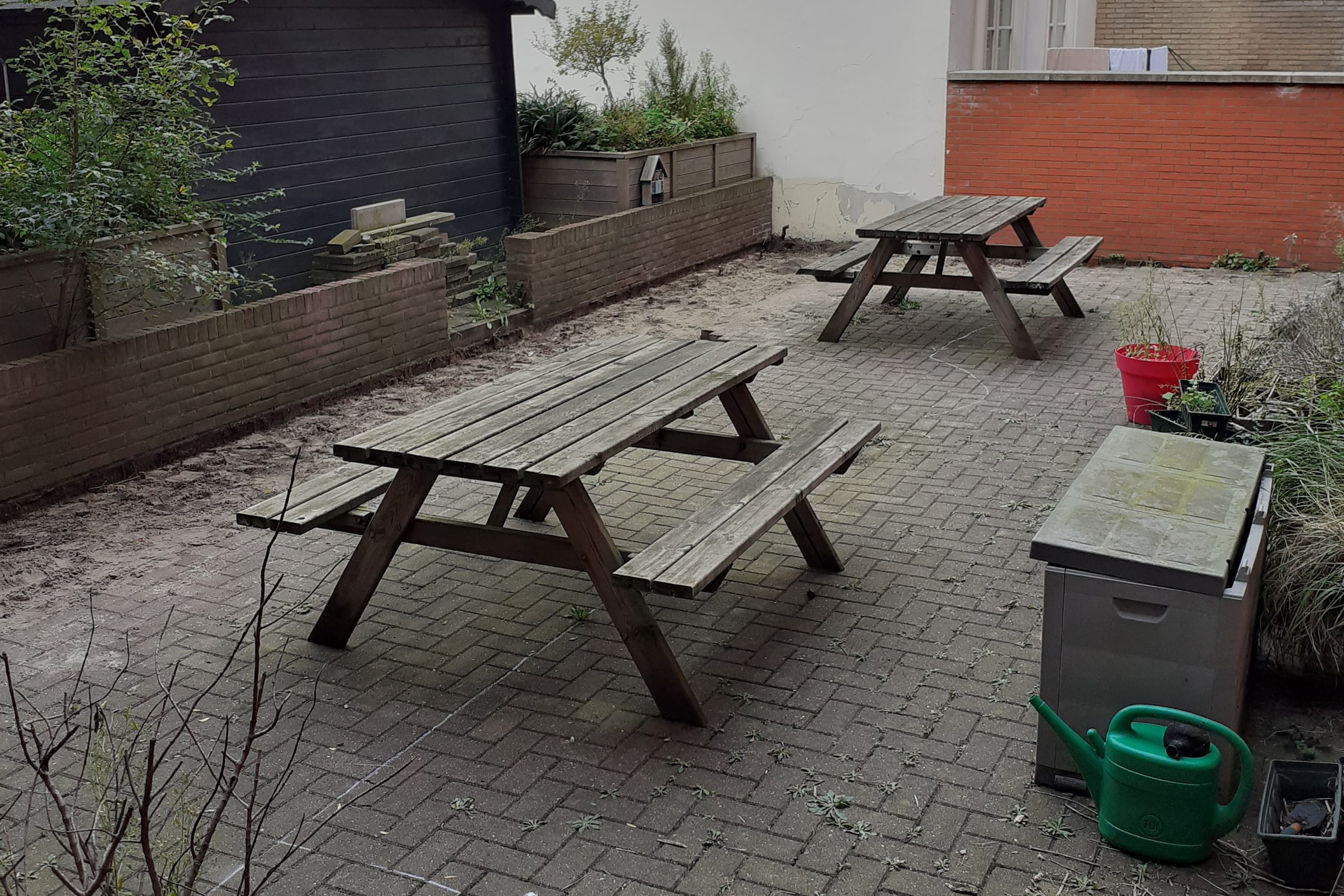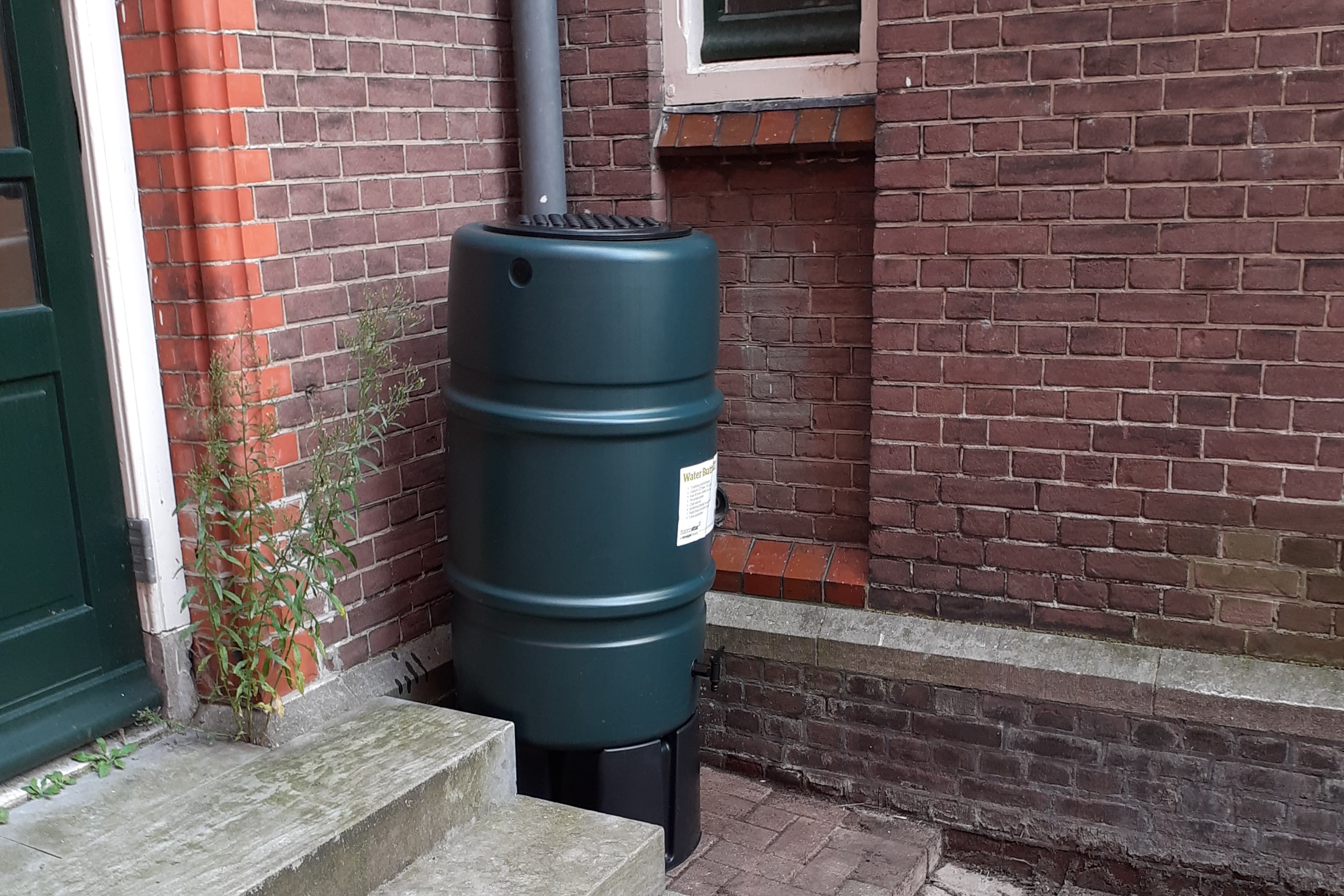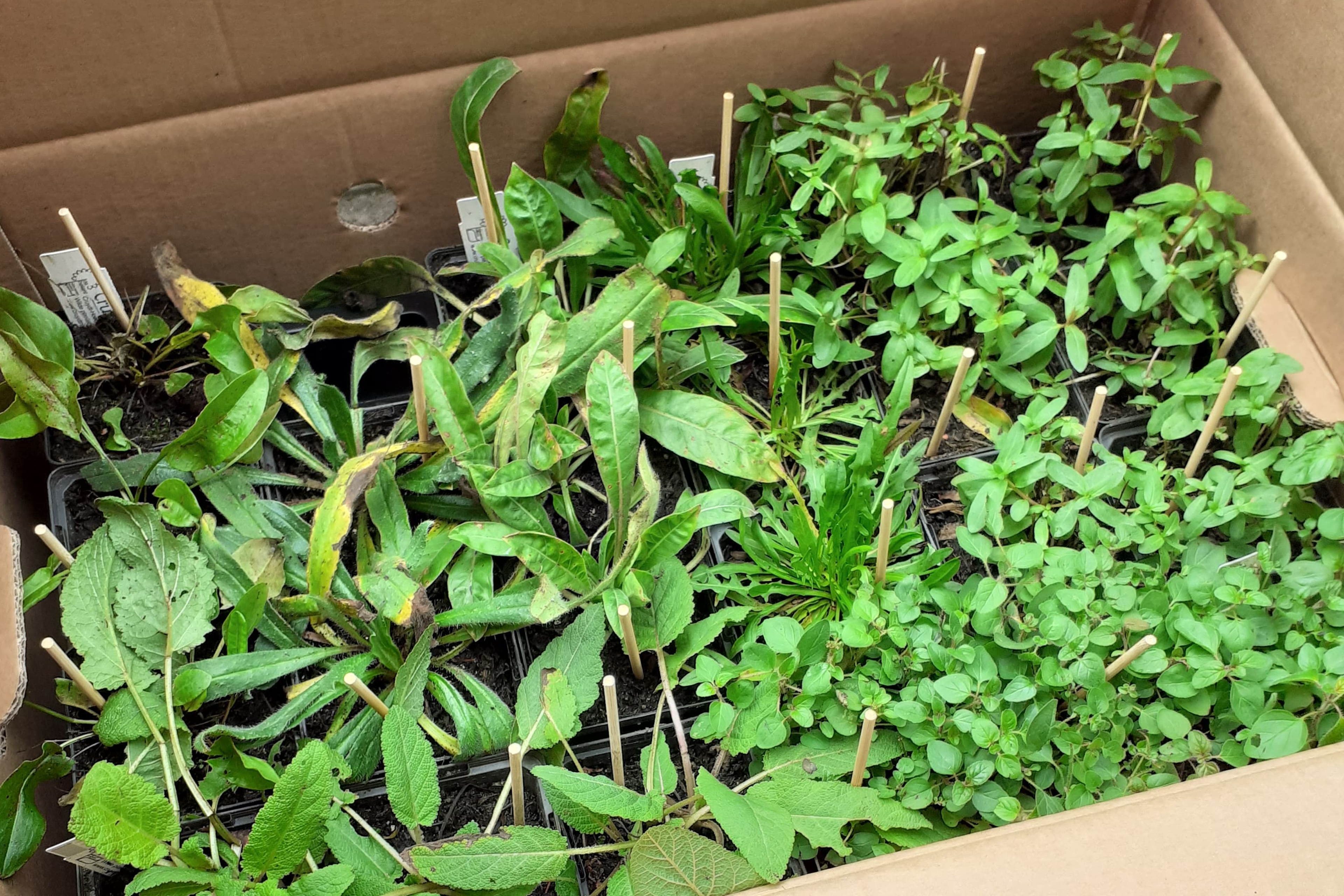Schouwburgstraat Community Garden
In September 2023, we started transforming a under-utilised outdoor space into a greener and more biodiverse garden in which all students and staff of the Schouwburgstraat can relax and enjoy.
Background
The Schouwburgstraat Building is located in The Hague. As a highly urbanised area, opportunities for large-scale greening and improving biodiversity are limited. However, the building has a backyard, which consisted of about 50 square metres of concrete tiles, with a few planters and picnic tables.
Around the summer of 2022 it came to the attention of LUGO that there was an outdoor plot within the schouwburgstraat building that could use a bit more attention. In line with our mission to make the university more sustainable, the idea came quickly to create a community garden for students and staff to enjoy. Following discussions with staff members of the building, LUGO was tasked with creating a design for this new community garden. As one of LUGO's aims is to foster co-creation and community engagement, we organised a competition in which students and staff could submit their ideas for a garden design in June of 2023. The winner was rewarded with a sustainable gift bag and this design was used as a base for the eventual design of the garden.
LUGO spoke with stakeholders including University Facility Department (UFB), Real Estate and student and staff members from Urban Studies and International Studies to co-create a design which was both sustainable by design and fit within the regulations of the university. Using inspiration from the winner of the competition, a finalized design was made in Sketchup and presented to UFB with the request to proceed with implementation. Finally, in October of 2023, we broke ground and removed around ten square meters of tiles, replacing this with organic soil and local plants. Many more action days together with volunteers followed, leading us to be able to officially 'open' the garden on the 8th of May with a special visit from the President of the Executive Board, Annetje Ottow.

About the garden
We wanted to make a beautiful, green space for students and staff to relax and come together, which also promotes local biodiversity. All the plants in the garden are native to the Netherlands, which is beneficial to pollinators such as bees and butterflies. A rain barrel was installed and will be used to water the garden during dry periods, to avoid wasting drinking water. The stored rainwater is also healthier for plants than tapwater, because it is less calcified.1
The idea is that the Schouwburgstraat community maintains the garden, with help from LUGO. It should be a space that allows those interested in gardening to have a place where they can help out and enjoy themselves. The garden can also be used to study, relax or during lunch breaks, when the weather is nice!
Benefits
Benefits for Pollinators
Due to their lack of greenery, cities can be a difficult place for pollinators (e.g. bees, butterflies) to survive. Green spaces are often too far apart for a flying insect, if they cannot stop to “refuel” on the way. Habitat fragmentation and destruction2 are a major driver for the worldwide decline of terrestrial insect species, which is estimated to be an average loss 10.56% per decade.3 Since The Netherlands is a highly urbanised country, it is especially difficult for pollinators to survive. However, some of the detrimental effects of habitat fragmentation can be minimised, if urban areas are sufficiently broken up by green areas. Ecologists have noticed the potential of smaller green spaces to act as “steppingstones” for biodiversity, and to form corridors between previously separated ecosystems.4 Therefore, even a small community garden can make a difference! Because these small patches of green help to create a network of green that pollinators can use to travel from place to place.
Conservation efforts for plants and pollinators in cities have traditionally been focussed on plants with large, colourful flowers to attract as many pollinators as possible. However, these flowers are often exotic and can have negative impacts on local biodiversity. This is because exotic species will compete with native species in order to establish themselves,5 which can lead to a loss of native biodiversity.6 A loss of native plants can be a big problem for pollinators as well, since some species of native pollinators (especially rarer species of specialist pollinators) depend on specific native plant species to survive. Therefore, we have chosen to only include native plants in this garden. An added benefit is that native plants are better suited for our local climate, which reduces the amount of maintenance they need.7
Benefits for People
More greenery in cities is not only beneficial for biodiversity conservation, but also for people. This is due to their many ‘ecosystem services’,8 which are benefits provided by nature. ‘Ecosystem services’ can range from recreation (cultural service) to lowering temperatures and absorbing excess rainwater (regulating services). Regulating services are especially important in cities, because these densely urbanized areas are often vulnerable to heat waves and local flooding after rainfall,9 because the soil cannot absorb all the water. Therefore, green spaces in cities can aid climate adaptation and mitigation.
Additionally, green spaces can be highly beneficial to the physical and mental health of people.10 Several studies have shown a positive relationship between the availability of local green areas, and residents’ health. Spending time in nature reduces stress, stimulates physical activity, and facilitates social cohesion. Therefore, we hope that the garden will provide a nice place for people to use for relaxing, recreation or studying.
We hope that this garden will lead to many more green initiatives within the University!
-

A work in progress - removing tiles and preparing the ground for planting new greenery -

Installing a rain barrel to conserve water, contributing to our eco-friendly efforts -

New plants for the garden
Sources
-
Ramos‐Jiliberto, R., Moisset de Espanés, P., & Vázquez, D. P. (2020). Pollinator declines and the stability of plant–pollinator networks. Ecosphere, 11(4), Volume 11-Issue 4.
-
van Klink, R., Bowler, D. E., Gongalsky, K. B., Swengel, A. B., Gentile, A., & Chase, J. M. (2020). Meta-analysis reveals declines in terrestrial but increases in freshwater insect abundances. Science, 368(6489), 417–420.
-
Lynch, A. J. (2018). Creating Effective Urban Greenways and Stepping-stones: Four Critical Gaps in Habitat Connectivity Planning Research. Journal of Planning Literature, 34(2), 131–155.
-
Stouffer, D. B., Cirtwill, A. R., & Bascompte, J. (2014). How exotic plants integrate into pollination networks. Journal of Ecology, 102(6), 1442–1450.
-
Jauni, M., & Ramula, S. (2015). Meta-analysis on the effects of exotic plants on the fitness of native plants. Perspectives in Plant Ecology, Evolution and Systematics, 17(5), 412–420.
-
Vanbergen, A. J., & Initiative, I. P. (2013). Threats to an ecosystem service: pressures on pollinators. Frontiers in Ecology and the Environment, 11(5), 251–259.
-
Depietri, Y., Renaud, F. G., & Kallis, G. (2011). Heat waves and floods in urban areas: a policy-oriented review of ecosystem services. Sustainability Science, 7(1), 95–107. https://doi.org/10.1007/s11625-011-0142-4
-
de Vries, S., van Dillen, S. M. E., Groenewegen, P. P., & Spreeuwenberg, P. (2013). Streetscape greenery and health: Stress, social cohesion and physical activity as mediators. Social Science & Medicine, 94, 26–33.

